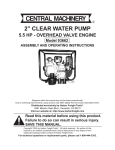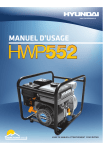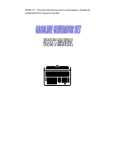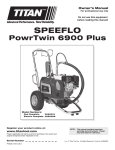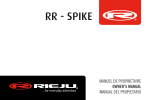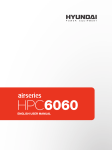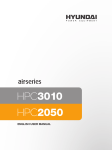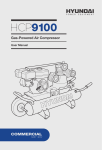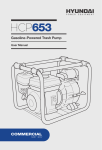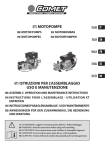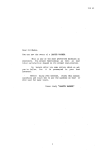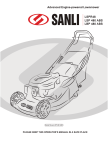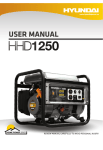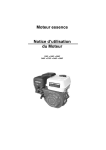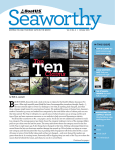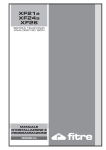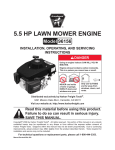Download Operating Guide
Transcript
Licensed by Hyundai Corporation, Korea EN PREFACE Thank you for purchasing a Hyundai water pump. Please register your product in order for us to ensure your continuous satisfaction with our product. This manual covers the safety, operation and maintenance procedures for the HWP552 model. All information in this publication is based on the latest product information available at the time of approval for printing. No part of this publication may be reproduced without written permission. If a problem should arise, please contact us by using the contact information at the end of this manual. It is important that this manual be read and fully understood before operating the pump. Failure to do so may cause serious injuries or equipment damage. 1. EN 2. Contents 1. SAFETY PRECAUTIONS 1.1) SAFETY LABELS.......................................... 3 1.2) OPERATION SAFETY................................... 3 2. IDENTIFICATION OF COMPONENTS................ 5 3. BEFORE STARTING 3.1) OIL LEVEL CHECK....................................... 3.2) FUEL LEVEL CHECK.................................... 3.3) AIR FILTER CHECK...................................... 3.4) HOSE CONNECTIONS................................. 3.5) PUMP PLACEMENT..................................... 3.6) PRIMING WATER......................................... 4. OPERATION 4.1) STARTING THE ENGINE.............................. 16 4.2) STOPPING THE ENGINE............................. 19 5. MAINTENANCE 5.1) IMPORTANCE OF MAINTENANCE............. 5.2) MAINTENANCE SCHEDULE....................... 5.3) ENGINE OIL CHANGE AND OIL DRAINAGE...................................................................... 5.4) AIR FILTER SERVICE................................... 5.5) SPARK PLUG SERVICE............................... 5.6) FUEL SEDIMENT CUP SERVICE................ 5.7) FUEL DRAINAGE.......................................... 5.8) IMPELLER CLEANING................................. 5.9) TRANSPORTATION...................................... 5.10) STORAGE................................................... 5.11) EXTERNAL PARTS CLEANING................. 9 10 11 12 13 15 20 20 21 22 24 26 26 28 28 29 30 6. TROUBLESHOOTING......................................... 31 7. SPECIFICATIONS................................................ 33 8. WIRING DIAGRAM............................................... 34 9. WARRANTY.......................................................... 35 10. GLOSSARY.......................................................... 38 EN 1. SAFETY PRECAUTIONS 1.1) SAFETY LABELS DANGER This symbol warns of harzards which can result in severe or lethal personal injury. WARNING This symbol refers to a hazardous or unsafe practice which has the potential to result in personal injury or product/property damage. CAUTION This symbol warns of immediate hazards which may result in severe or lethal personal injury. 1.2: OPERATIONS SAFETY • • • • • • • • The water pump must not be operated by anyone under the age of 16. Never operate the engine when transporting the unit. Never operate the water pump if you are tired or if you are under the influence of alcohol, drugs, medication or any other substance that could affect your ability or judgement. Always do a pre-operation inspection before each use. Operate the water pump according to instructions for safe and dependable service. Before operating the water pump, read the user manual carefully. Otherwise, it may result in personal injuries or equipment damage. When operating the water pump, keep small children away from the area of operation. Make sure the surface underneath the pump is levelled and firm. Placing the pump at an angle will cause gasoline leakage. 3. EN • • • • • • • • • • • • • 4. • • • Do not operate the water pump indoors. Make sure the area of operation and maintenance is well ventilated. Do not remain near the working water pump for a long time, as the water pump emits poisonous carbon monoxide gas. Do not use the water pump to work with flammable liquids such as gasoline. Do not use the water pump to work with caustic liquids such as used oil, milk or wine. Do not pump liquids and/or chemical solutions such as sea water which may cause corrosion. Keep the working water pump at least 1.5 meters away from any static objects such as cars or buildings in order to ensure proper ventilation and prevent fire hazards. Always stop the engine and allow it to cool before refuelling Avoid overfilling and wipe off any fuel that may have spilled. Never place flammable material close to the engine muffler. Never overturn the water pump when storing or transporting. Overturning will cause leakage of vital liquids. Never smoke or light fires near the unit. Never make unauthorized attachment installations. Always disconnect the spark plug wire before performing any maintenance work. Always keep the unit as clean as possible. Keep it free of loose vegetation, mud, etc. Always be already to stop the unit immediately if it suddenly begins to vibrate or shake. Inspect for broken, missing or improperly installed parts. Never refuel the water pump while the engine is running. Gasoline is very flammable and may ignite when in contact with hot engine parts. EN 2. IDENTIFICATION OF COMPONENTS Fuel tank Discharge Port Choke lever Throttle lever 5. Oil Dipstick Fuel valve Lever Fuel drain screw starter handle Oil drain screw Engine Switch EN Primer opening Air filter Water pump 6. Inlet port Engine Block Exhaust AIR CLEANER MAINTENANCE ENTRETIEN DU FILTRE À AIR • Rinse with cleansing solvent and dry • Wash filter with solvent every 45 to 50 hours of operation • Wash filter once every 10 hours if operating under dusty conditions • Immerse the filter into engine oil when clean and dry, then squeeze out excessive oil and reinstall • Rincer avec un liquide nettoyant et faire sécher • Lavez le filtre avec un liquide nettoyant après chaque 45 à 50 heures d’utilisation • Lavez le filtre une fois à chaque 10 heures si vous l’utilisez en conditions poussiéreuses • Plongez le fitre dans du carburant à moteur une fois bien lave et séché, ensuite enlever le liquide de surplus et réinstallez le filtre EN LABEL PLACEMENT WARNING! 5.5HP www.hyundaipower.ca INCREASE POWER DECREASE POWER Starting the engine with the water pump unprimed will burn the seal. Always prime before usage. AVERTISSEMENT! Démarrer le moteur avec la motopompe sans couche de base pourrait détruire le sceau. Toujours mettre une couche de base avant d'utiliser. 7. ON ACTIF OFF INACTIF CLOSE FERMER OPEN OUVERT Add oil before use! Water pump ships without oil! Ajouter de l’huile avant l’usage! Le pompe d’eau est livrée sans huile! EN LABEL PLACEMENT THIS ITEM CANNOT BE RETURNED TO STORE ATTENTION! ATTENTION! • Never add fuel when the engine is running • Never add fuel when engine is hot • Always add fuel in a well-ventilated area • Always clean up fuel spills • Ne jamais ajouter du carburant lorsque le moteur est actif • Ne jamais ajouter du carburant lorsque le moteur est chaud • Toujours transférer le carburant dans un endroit bien ventilé • Toujours ramasser les fuites de carburant WARRANTY SERVICE IS ASSURED BY HYUNDAI POWER CANADA. CONTACT AT 1-877-528-3772 OR WWW.HYUNDAIPOWER.CA FOR ASSISTANCE. CE PRODUIT NE PEUT PAS ÊTRE RETOURNÉ AU MAGASIN. TOUTE PROCLAMATION ET RÉPARATION SOUS LA GARANTIE SERA ADRESSÉE PAS HYUNDAI POWER CANADA. CONTACTEZ 1-877-528-3772 OU WWW.HYUNDAIPOWER.CA POUR DE L’ASSISTANCE. 8. HOT EXHAUST! DO NOT TOUCH! ECHAPEMENT CHAUD! NE PAS TOUCHER! In order to maximize the service life of your water pump, always do a pre-operation inspection before every run: 1) Look underneath the water pump to check for any puddles of leaking fluids. 2) Inspect the water pump for any signs of physical damage. 3) Check whether all nuts, screws, bolts, and clamps are tight and not loose. 4) Make sure the hoses which you are using are the reinforced construction type. 5) Check engine oil level 6) Check air filter 7) Check fuel level EN 3. BEFORE STARTING WARNING Be sure to check the pump on a level surface with the engine stopped. 9. WARNING Low oil level will cause serious damage to a running engine. 3.1: Oil Level Check 1. Remove the oil filler cap and wipe the dipstick clean (Refer to Fig. 3.0) 2. Check the oil level by inserting the dipstick into the filler check without rotating. If the level is low, fill to the upper limit of the oil filler neck with the recommended oil. (Refer to Fig. 3.1) 3. Reinstall the oil filler cap and tighten carefully. Oil filler cap Fig. 3.0 Dipstick EN Upper Limit Lower Limit Fig. 3.1 WARNING Engine oil is a major factor affecting engine performance and service life. Non-detergent or vegetable oils are not recommended. 3.2: Fuel Level Check WARNING 10. - Gasoline is extremely flammable, and explosive under certain conditions. Refuel in a well ventilated area with the engine stopped. Do not allow smoking, a naked flame or electrical sparks to occur during refilling. - Avoid spillage and wipe up spills immediately. - Keep stored gasoline out of the reach of children. 1. Turn the engine switch to OFF position before filling the fuel tank. (Refer to Fig. 3.2) Fig. 3.2 ON ON OFF OFF EN 2. Remove the fuel cap and check the fuel level. (Refer Fig. 3.3) Fig. 3.3 Fuel Cap 3. Refill the fuel tank if the level is low. Refuel carefully to avoid spilling fuel. 11. 3.3: Air Filter Check WARNING Never run the engine without the air filter. Rapid engine wear will result from contaminants, such as dust and dirt, being drawn into the engine. 1. Unscrew the wing nut, remove the air filter cover and inspect the air filter sponge. (Refer to Fig. 3.4) Wing 2. Observe the sponge for cleanliness. Nut Fig. 3.4 Air FIlter Cover Filter Sponge EN 3. Clean the sponge with soapy water or inflammable solvent. Squeeze dry and then soak in clean engine oil. Squeeze out all excess oil and reinstall. 4. Replace the sponge if it is damaged. 3.4: Hose Connections 1. Insert adapters into one end each of the suction and discharge hoses, and attach O-rings to the adaptors. 2. Tighten the hose clamp around the discharge hose until the connection is airtight. 3. Insert a strainer into the suction hose, and tighten the hose clamp around the suction hose until the connection is airtight. 4. Screw the adapters into the appropriate pump fittings. Avoid sharp bends in the hoses, and don’t allow heavy objects to com3. Insert press the hoses. (Refer to Fig. 3.5) Hose Clamp Strainer 1. Connect hose 2. Tighten and Stainer Cap 12. O Ring Hose Adaptor Suction Hose 4. Tighten Hose Clamp Clamp Ring Strainer Cap Coupler Strainer Hose Clamp Fig. 3.5 Water pump placement is an important step for ensuring a more efficient and effective pump. 1. Ensure that the suction head is less than the discharge head. 2. Increasing the discharge head will decrease water output. 3. Make sure the pump is primed to minimize the suction head. Refer to Fig. 3.6 EN 3.5: Pump Placement Discharge Head Total Head Suction Head Bad Placement 13. Discharge Head Total Head Suction Head Good Placement Fig. 3.6 EN 14. NOTICE: Suction head is the height to which a pump can raise water on the suction side, measured from the water level in the sump. Discharge head is the vertical distance between the intake level of the water pump and the level at which it discharges water freely to the atmosphere. Total head is the sum of the suction head and the discharge head. EN 3.6: Priming Water NOTICE: Prior to running the pump, always make sure to prime it with water. Priming will create a vacuum that will help to start the water flow. 1. Unscrew the primer cap 2. Insert the neck of the water container into the opening and gradually tilt until the reservoir is full. (Refer to Fig. 3.7) 3. Tighten the cap back on 4. In case of a dry operation, stop the engine immediately and allow it to cool before priming. Fig. 3.7 15. Primer Cap WARNING Never run the pump unprimed as doing so will overheat and damage the engine. CAUTION Avoid spilling water when filling the storage container. EN CAUTION Make sure that the priming water and the container are free of any debris. 4. OPERATION 4.1: Starting the engine WARNING Opening the throttle immediately after starting the pump will not provide enough time for the parts to lubricate. 16. 1. Prime the pump. (Refer to Fig. 4.1.1) 2. Slide the fuel valve lever to the ON position. (Refer to Fig. 4.1.2) 3. Slide the choke lever to the CLOSE position. (Refer to Fig. 4.1.2) 4. Adjust the throttle lever to about ¼ of the way to the left direction. (Refer to Fig. 4.1.3) 5. Turn the engine switch to the ON position (Refer to Fig. 4.1.4) 6. Pull the starter grip gently until resistance is felt. Then pull it briskly and the engine should start. Repeat the process if the engine does not start. (Refer to Fig. 4.1.5) 7. After the engine warms up (above 50oF), turn the choke lever to the OPEN position. Priming Cap Fig. 4.1.1 EN Fig. 4.1.2 Choke Lever OPEN OFF Fuel Valve Fig. 4.1.3 Throttle Lever CLOSE ON 17. EN Fig. 4.1.4 ON OFF ON OFF Fig. 4.1.5 18. CAUTION Return the starter grip gently. Do not allow it to snap back or the starter may be damaged. NOTICE: Set the throttle to the full open position to obtain maximum pump output. If necessary the flow rate can be regulated by adjusting the throttle position. EN 4.2: Stopping the Engine 1. Return the throttle lever to the idle position (to the right end). (Refer Fig. 4.1.3) 2. Turn the engine switch to the OFF position (Refer to Fig. 4.1.4) 3. Turn the fuel valve to the OFF position (Refer to Fig. 4.1.2) NOTICE: In an emergency the engine can be quickly stopped by simply turning the engine switch to the OFF position. WARNING In case of an emergency, do not cut down the throttle but rather switch the engine off right away using the engine switch. 19. EN 5. MAINTENANCE 5.1: Importance of Maintenance Proper maintenance is important because it will ensure safe, economical and trouble-free operation. It will also reduce air pollution. Improper maintenance may cause the water pump to malfunction and can lead to serious injuries or deaths. 5.2: Maintenance Schedule Item Remarks Spark Plug Check condition, adjust gap and clean. Replace if necessary 20. Engine Oil Check Oil Level Replace Air Filter Clean, replace if necessary Fuel filter Clean fuel valve and fuel tank filter. Replace if necessary Valve Clearance Check and adjust when engine is cold. Daily (Preoperation Check) First Three Month Months (20 (50 hrs) hrs) Six Months (100 hrs) Twelve Months (300 hrs) х х х х х х х Fuel line х Check for leakage. Retighten or replace gasket if necessary. х EN Check fuel hose for cracks or other damage. Replace if necessary. Exhaust System Check muffler screen. Clean or replace if necessary. Carburetor Check choke operation х 21. х Check for Cooling rain damSystem age Check reStarting coil starter System operation х х х 5.3: Engine oil Change and Oil Drainage WARNING Used motor oil can cause skin cancer if repeatedly left in contact with skin for long periods of time. Wash your hands thoroughly with soap and water as soon as possible after handling oil. EN CAUTION Do not dispose of used oil by pouring it down the drain or on the ground. Pour used motor oil into the container and take it to your local service shop for environmentally friendly disposal. 1. Stop the engine 2. Remove the oil filler cap. (Refer to Fig. 5.1) 3. Place a pan under the engine. 4. Remove the oil drain screw and let the oil drain completely into the pan. (Refer to Fig. 5.1) 5. Reinstall the drain screw and refill the engine with oil to the upper limit using a funnel. (Refer to Fig. 3.1) 6. Reinstall the oil filler cap. Oil Drain Screw Oil Filler Cap Fig. 5.1 22. 5.4: Air Filter Service WARNING Using gasoline or other flammable solvent to clean the filter element can cause a fire or explosion. EN WARNING Never run the water pump without the air filter, this will cause rapid engine wear. 1. Unscrew the air filter cover. (Refer to Fig. 5.2) 2. Remove the filter element and wash well with an inflammable solvent or soap and water, then dry. 3. Pour a small amount of oil into the filter element and gently squeeze out excess oil. Never wring out the filter element, as it may tear. The engine will smoke if too much oil remains in the filter element. (Refer Fig. 5.3) 4. Reinstall the filter element and air filter cover, ensuring the air filter cover seals completely. Fig. 5.2 23. Wing Nut Filter Cover Filter Element EN 24. Fig. 5.3 5.5: Spark Plug Service CAUTION Never rinse your spark plug with water as it will damage the spark plug. CAUTION Follow the guidelines and do not over tighten the spark plugs. CAUTION Tighten ½ turn when installing a new spark plug. EN CAUTION Tighten 1/8-1/4 turn when re-installing an old spark plug. 1. Disconnect and remove the spark plug using a wrench. 2. Inspect the spark plug and clean any dirt or debris from the electrodes with a wire brush. Replace if the electrodes are worn or the insulator is damaged. 3. Measure the electrode gap with a spark plug gauge or feelers and adjust as necessary by carefully bending the side electrode. The gap has to be between 0.7 - 0.9 mm. (Refer to Fig. 5.4) 4. Install the plug carefully by hand. Then tighten it with a spark plug wrench. Fig. 5.4 Spark Plug 25. Spark Plug Wrench 0.7-0.9 mm gap distance Side Electrode EN 5.6: Fuel Sediment Cup Service 1. Move the fuel valve to the OFF position. 2. Unscrew the sediment cup using a wrench and remove the Oring. 3. Wash the cup and O-ring in non-flammable solvent and dry thoroughly. 4. Place the O-ring in the fuel valve then screw the sediment cup into place and tighten securely. 5. Move the fuel valve to the ON position and check for leaks. Replace the O-ring if there is leakage. Fig. 5.5 26. O Ring Sediment Cup 5.7: Fuel Drainage CAUTION Never store fuel in any other all-purpose container as the gasoline may be affected. EN 1. Purchase a proper plastic fuel container from your local gas station or general store. 2. Place the container underneath while removing the drain screw from the carburetor. 3. Turn the fuel valve to the ON position and slowly remove the fuel drain screw from the carburetor. (Refer to Fig. 5.6) 4. Allow the fuel to drain fully and then drive the screw back in. Fig. 5.6 OFF ON 27. Sediment Cup Fuel Drain Screw EN 5.8: Impeller Cleaning Impeller cleaning is important when storing the water pump for a long period of time, as well as considered good practice during regular maintenance checks. 1. Fill up the pump with fresh water through the primer opening. 2. Start the pump and let it run for 5 to 8 minutes or until water evaporates upon contact with the engine block. 3. Drain the water through the pump drain outlet. 4. Flush the pump with clean water pouring it through the primer opening. 5. Drive the drain screw back on. 28. Water drain screw pump drain outlet 5.9: Transportation WARNING Contact with a hot engine or exhaust system can cause serious burns or fires. Let the engine cool down before transporting the unit. EN CAUTION Take care not to drop or strike the pump while transporting. Do not place heavy objects on the pump. CAUTION Never operate a damaged or defective motor! When adjusting or making repairs to your pump, disconnect the spark plug wire from the spark plug and place that wire where it cannot contact the spark plug. Do not use a garden hose to clean the pump because water can enter the fuel system and cause problems. • Make sure the engine switch and fuel valve are in the OFF positions. • Keep the unit level to prevent spillage. • Secure the pump to the surface it rests on to prevent unwanted movement during transportation. 5.10: Storage WARNING Do not store close to extreme heat, flames or sparks as the water pump may ignite. WARNING Do not store in an extremely humid and dusty areas as such environments may damage the components. WARNING Do not store with gasoline in the carburetor and gas-tank. 29. EN 1. Clean the impeller and drain all the water out. 2. Drain out the gasoline and store the container in a heat, flame and spark free place. 3. Change the engine oil by draining the old and replacing it with the new. 4. Slide the fuel valve to the OFF position. 5. Place the water pump in an appropriate storage area at temperatures above 0oC. 6. Cover the intake and discharge port. 7. Cover the entire pump with fabric to protect it from dust. 5.11: External Parts Cleaning Keeping the external parts clean can prevent debris build up/hardening, and ensure easy access during maintenance periods. WARNING Never pressure wash the water pump as water may damage electrical components. 30. 1) Place the water pump in a well lit area 2) Use a grease/oil removing solvent and a cloth to clean areas around the gas tank and the oil dipsticks. 3) Using a damp cloth to rub off the remaining residue and any debris. 4) Allow the unit to air dry EN 6. TROUBLESHOOTING If the engine won’t start: Cause Action Engine switch not ON Turn the engine switch to ON position. Faulty spark plug Use a wrench to remove the spark plug and remove any dirt or debris on the electrode. Fuel line clogged Check the fuel line for any leaks. Unclog the fuel line if needed. Fuel valve not ON Turn the fuel valve to the ON position. Choke valve OPEN Turn the choke lever to the CLOSE position if the engine is cold. Wrong fuel type Drain out the fuel, and clean the fuel line. Carburetor not getting fuel or air Take the pump to an authorized service dealer. Dirty air filter Disassemble and clean the air filter. Empty fuel tank Fill up the fuel tank Low oil level Add oil and restart the engine. Starter not functioning Take the pump to an authorized service dealer. If power is low: Cause Action Dirty air filter Clean air filter Throttle lever unadjusted Slide the throttle lever to increase the power output. If water output is low: Cause Action Clogged Strainer Clean the strainer; rinse out all debris with water. Suction hose blocked with foreign material Clean out the hose. 31. EN Damaged hoses Purchase new hoses of appropriate length/width Impeller clogged Remove obstruction Hose clamps loose Tighten or replace the hose clamps Seal leak Take the water pump to an authorized service dealer Incorrect pump placement Reposition the pump Incorrect hose length/ width Replace the hoses with ones of appropriate length/width If there is no water ouput: Cause 32. Action Incorrect pump placement Reposition the pump Pump is not primed Prime the pump Pump mechanism is damaged Take the pump to an authorized service dealer Gas Tank Capacity 3.6 L Oil Reservoir Capacity 0.6 L Power Output 5.5 HP OHV Gas Engine Displacement/Stroke 163cc, 4-stroke Total Head 105 ft Total Lift 25 ft Maximum Speed 4000 RPM Maximum flow 36,000 litres/hr Cooling System Air-forced Maximum Power Output 4.0 kW at 3600 RPM Maximum Torque 9.5N.M/2800 RPM Spark Plug Type F6TC Gasoline Type unleaded Oil Type 15W40 Operation Temperature Range -5 to 40 degrees Noise level 66 dB Weight 26 kg EN 7. SPECIFICATIONS 33. EN 34. 8. WIRING DIAGRAM Canadian distribution of Hyundai Water Pumps are distributed by: EN 9. WARRANTY Midland International 26 Huddersfield Rd. Unit #2 M9W-5Z6 Canada This product is warranted to be free of defects in material and workmanship for two years from date of purchase. This warranty guarantees that any defective parts will be repaired or replaced at no cost, including diagnosis and replacement parts. Limited Warranty periods: Recreational/residential use: 2 years limited. 1st year, parts and labor. 2nd year parts only. Commercial use: 6 months limited, parts and labor This limited warranty begins at the initial time of retail purchase and covers manufacturer’s defects caused by a defect in components or workmanship during the two (2) Year period. The warranty coverage is continual from the initial date of purchase and does not restart at anytime under any circumstances. This limited warranty is valid for residential or recreational applications only and only when the pump receives all necessary preventative maintenance as described in the Hyundai Water Pump Operation Manual. The repair or replacement of a pump will take place within a reasonable period of time during normal business hours. All repair and replacement parts shall be warranted for (90) days after the initial date of installation or purchase. Limitation of Remedies and Disclaimers Midland International Inc. disclaims any responsibility for loss of time or use of the pump in which the pump is installed, transportation, commercial loss, or any other incidental or consequential damage. Any implied warranties are limited to the duration of this written warranty. THE FOREGOING LIMITED WARRANTY IS EXCLUSIVE OF AND IN LIEU OF ALL OTHER WARRANTIES OF MERCHANTABILITY, FITNESS FOR A PARTICULAR PURPOSE AND OF ANY OTHER WARRANTY WHETHER EXPRESS OR IMPLIED. 35. EN Consumable parts, such as oil or fuel filters, fuel cut off valve, brushes, fuel injection nozzle valve, lubricant, or ignition plug, are not covered under this warranty. All expenses incurred in maintaining and replacing parts for pump shall fall on the purchaser. This warranty coverage does not include parts affected by accident and/ or collision, corrosion or rust, normal wear, incorrect fuel type or fuel contamination, use in an application for which the product was not intended, unauthorized service, or any other misuse, neglect, incorporation or use of unsuitable attachments or parts will not be covered under this warranty. Under this Warranty, we do not have the obligation to bear any transportation fees of any product to/from an authorized Warranty Center. Unauthorized alteration, installation or any cause other than defects in material or workmanship of the product will not be covered under the warranty. Exclusions 36. Not Covered by this Limited Warranty: 1) Normal engine/alternator wear; 2) Damage caused by lack of maintenance as described in the Hyundai manuals, or negligence by using improper or impure motor oil, coolant, or fuel; 3) Damage caused by accidents, improper installation or storage; 4) Damage caused by water ingestion, submersion, or external water damage; 5) Damage or non-performance caused by operation of the pump in a marine application; 6) Damage caused by operation with improper fuel, or at speeds, loads, conditions, or modifications contrary to published specifications. 7) Items not supplied by Hyundai, including, but not limited to; external wiring, fuel lines, filters, etc;(refer to exclusions) 8) Repairs made during the warranty period, without first obtaining a case number from Hyundai Product Registration The warranty registration card must be sent to Midland within 30 days of purchase along with the UPC (Universal Product Code) label on the box. The registration card can be found in the box. The UPC label is the barcode used to scan at the time of purchase and is located on the bottom right corner of the box. To register your pump by mail, submit both UPC label and completed registration card for the address listed on the card. You can also register your pump online at www.hyundaipower.ca (UPC label EN must still be mailed to the address listed on the registration card). Upon receipt of this registration, Midland will record and register your warranty. No verification of registration and warranty will be sent to the purchaser. NO WARRANTY COVERAGE WILL BE ALLOWED UNLESS YOUR PUMP IS REGISTERED WITH MIDLAND AND UPC LABEL IS PROVIDED. Warranty Claim Procedure: Warranty service must be performed by one of our authorized service dealers. If you feel your pump is malfunctioning due to a defect or misuse, simply contact our customer support center for technical advice, a warranty claim or general information. Do not return your pump to the place of purchase for repair. MIDLAND INTERNATIONAL INC. SHOULD BE CONTACTED TO PROVIDE A CASE NUMBER BEFORE WARRANTY WORK CAN BEGIN. To obtain warranty service: Contact our customer support centre: Toll free: 1-877-528-3772 E-mail: [email protected] Website: Hyundaipower.ca 37. EN 10. GLOSSARY Air Filter- It removes dust from engine intake air. Carburetor- A device used to properly mix fuel and air in the correct proportions and delivering the mixture into the engine’s combustion chamber. Choke Lever- It is used to provide proper starting mixture when the engine is cold. The choke lever must be pulled out to ON position when starting a cold engine. Dipstick- It seals off engine oil fill hole and is used for indicating the oil level. Fuel Valve- It controls flow of fuel from fuel tank to carburetor. Impeller- Rotating part of a pump which forces a fluid under pressure in a desired direction. 38. Priming- introducing water into a pump to improve the seal and start the water flowing. Recoil Starter- A pull cord is attached to the engine and you pull the T-handle attached to the starter cord assembly to spin the flywheel and start the engine. Spark Plug- A device screwed into the combustion chamber of a spark ignition engine. The plug supplied the spark that ignites the air/fuel mixture so that combustion can occur. Strainer- It prevents any large pieces of debris from entering the hose and damaging the pump mechanism. EN 39. EN 40. EN 41.













































